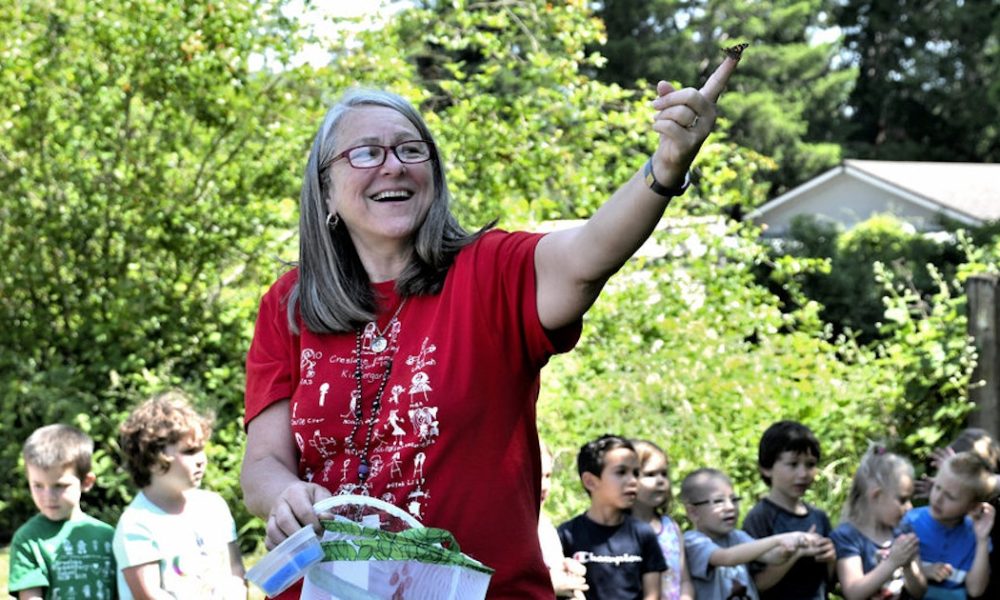 Teacher Cheryl Clancey gives one of the Painted Lady butterflies hatched by Creslane kindergartners a bit of encouragement before it flies into the nearby trees. Gini Davis/The Creswell Chronicle
Teacher Cheryl Clancey gives one of the Painted Lady butterflies hatched by Creslane kindergartners a bit of encouragement before it flies into the nearby trees. Gini Davis/The Creswell Chronicle
”Butterfly, butterfly, fly away. Butterfly, butterfly, have a good day,” sang the students of Creslane kindergarten teachers Cheryl Clancey, Debbie Larson, Shawna Bradley and Nastalia Raines as about two dozen Painted Lady butterflies fluttered out of their mesh enclosures to settle on the grass nearby or in the trees at the eastern edge of the school grounds.
On May 31, the kindergartners stood in a big circle as their teachers released the butterflies each class had raised and hatched from caterpillars. It’s an annual event at Creslane that allows students to learn about and observe the lifecycle of the delicate winged creatures.
Each of the four kindergarten classes typically receives a cup containing five Painted Lady caterpillars – but after a couple of years in which some failed to hatch or were deformed, each class received six caterpillars this year.
”I think all of them hatched,” Clancey said, ”and they’re all strong and healthy.”
”As soon as we brought ours outside into the light, they started flying around trying to get free,” Larson added.
The butterfly release is always a special moment for kindergartners, who have watched their caterpillars grow, form chrysalises, and emerge when their metamorphosis into butterflies is complete.
Once the children had sung their song of encouragement, complete with fluttering hand motions, the teachers opened the net enclosures and the vigorous, newly fledged Painted Ladies began flying out. Only a few had to be coaxed from the bottom of the enclosures on teachers’ fingers before rewarding their young stewards’ caretaking by flying free.
”It’s a special time every year,” Larson said.
Painted Lady Butterfly Fun Facts:
• Their entire lifecycle, from egg to larvae/caterpillar, pupa/chrysalis and adult, takes less than a month.
• Their eggs are light green and tiny as a pin tip. After hatching, the new caterpillar eats its egg.
• The caterpillars will eat thistle, sunflower, okra and other plants in the Asteraceae family.
• The caterpillars shed their skin four times as they grow.
• They spin silk to help support and protect themselves.
• The caterpillars hang upside down in a “J” shape when ready to pupate.
• The chrysalis is made from hardened protein as the caterpillar sheds one last time.
• In the chrysalis, much of the caterpillar’s body liquifies and reassembles as a butterfly.
• A few hours before the butterfly emerges, the chrysalis turns dark; a few minutes before it emerges, the chrysalis becomes clearer and the wings can be seen through it.
• The new butterfly’s wings are wet and folded, and it cannot eat or fly. It hangs from the chrysalis to dry, harden and stretch its wings and body.
• The butterfly’s “tongue” is a hollow proboscis rolled beneath its face; the butterfly uses it like a straw to sip nectar.
• Butterflies “breathe” through spiracles – small holes in their bodies.
• Painted Lady butterflies enjoy eating fruits and sugar water. Their predators include wasps, mantises and birds.
• Painted Ladies live on every continent except Australia and Antarctica.
• Painted Ladies sometimes migrate, flying up to 100 miles per day, at speeds approaching 30 mph.
• Adult Painted Ladies live about only two weeks.








